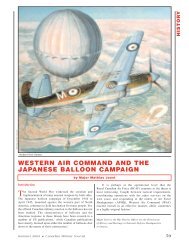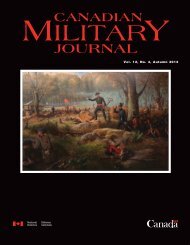MILITARY
CA JOURNAL - Revue militaire canadienne
CA JOURNAL - Revue militaire canadienne
- No tags were found...
Create successful ePaper yourself
Turn your PDF publications into a flip-book with our unique Google optimized e-Paper software.
VIEWS AND OPINIONS<br />
Credit: DND photo HS2012-0803-009 by Master Corporal Peter Reed<br />
move would put Canada in line with allies such as the<br />
United Kingdom, Belgium, France, and Brazil, all of<br />
which have proven their PPF capability in contemporary<br />
and diverse operating environments.<br />
3. Publication of a Force Employment Concept. A force<br />
employment concept (FEC) would address the first two<br />
points and provide the necessary blueprint to allow commanders<br />
to effectively field PPF groupings during exercises<br />
and operations. Too often, during the planning and conduct of<br />
exercises, the Pathfinder phase is omitted. This is a detriment<br />
to planners, training audiences, and Pathfinders alike, and it<br />
hinders the CAF’s efforts to confirm readiness.<br />
Conclusion<br />
Canada’s Patrol Pathfinders represent an important and<br />
unique capability available to a commander. They are<br />
primed to execute the initial phase of most operations involving<br />
the insertion of forces into a new or immature theatre.<br />
They also are trained to play a critical role in the evacuation of<br />
non-combatants, facilitate the delivery of humanitarian assistance,<br />
and other high value tasks that implicate conventional<br />
forces. This article has considered that role in some detail<br />
while providing an overview of the capability’s employment.<br />
Further, despite its relative and necessary brevity, it has also<br />
outlined some recommendations for consideration, with a<br />
desire to spark further discussion and debate. Future engagements<br />
(academic or otherwise) about the PPF capability might<br />
consider its history in more detail, the nature of PPF operations,<br />
and Allied Pathfinder capabilities.<br />
Captain Cullen Downey, a graduate of the United States Ranger<br />
School, has a Light Infantry background, having served as a platoon<br />
commander within Parachute Company, 3 rd Battalion, The Royal<br />
Canadian Regiment as the battalion’s reconnaissance platoon commander.<br />
He is currently in charge of the Patrol Pathfinder Cell at<br />
the Canadian Armed Forces Land Advanced Warfare Centre.<br />
Captain Nick Deshpande is a Canadian Army intelligence<br />
officer, and has previously served with CANSOFCOM and 3 rd<br />
Battalion, The Royal Canadian Regiment. He is currently a team<br />
leader with the Army Intelligence Group implementation team.<br />
Both authors would like to gratefully acknowledge the contributions<br />
of Captain Matt Tamsett (3 PPCLI) and Lieutenant<br />
Colonel (Ret’d) Steve Nash (The RCR).<br />
NOTES<br />
1 The Pathfinder capability resided in the airborne<br />
reconnaissance force of the Canadian Airborne<br />
Regiment. With the Regiment’s disbandment in<br />
1995, there was no longer a valid and relevant<br />
force employment concept.<br />
2 Typically up to 72 hours.<br />
3 A.B. Godefroy, (Ed). Land Operations 2021:<br />
Adaptive Dispersed Operations – the Force<br />
Employment Concept for Canada’s Army of<br />
Tomorrow. (Kingston, ON: Army Publishing<br />
Office, 2007), p. 18.<br />
Vol. 13, No. 4, Autumn 2013 • Canadian Military Journal 57





